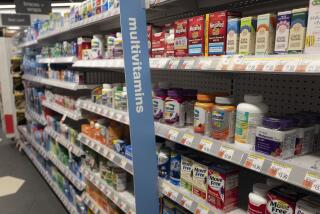A Dose of Marketing : Irvine Vitamin Firm Alacer to Begin Advertising
IRVINE — Jay Patrick, just shy of his 83rd birthday, goes to work every day in offices cluttered with electronic gadgetry and books and articles about health and nutrition. A sofa bed in one corner is always open so he can take his daily 22-minute nap.
The founder and president of a 23-year-old Irvine company that makes vitamins and other food supplements counted the late Linus Pauling among his friends. In fact, he credits the Nobel-prize winning chemist with getting him into his line of work.
Now, he is one of his own best customers. He takes 10 grams of vitamin C every day--about 150 times the recommended daily allowance--because, he says, it ensures his good health and vitality.
After years in relative obscurity, Patrick has decided to raise the profile of Alacer Corp. by making a push into the rapidly growing health-food segment of the retail industry. Alacer, which sells its products in health-food stores nationwide, will begin advertising and marketing its full line of vitamin and mineral tablets, bottled water with electrolyte additives and vitamin-enriched skin-care products.
Privately held Alacer is timing its marketing move well, observers and analysts say. The vitamin industry as a whole has seen its sales grow steadily in the 1990s. Total sales of food supplements were a record $4 billion for 1993, according to the Council for Responsible Nutrition, a trade group based in Washington. That represented a 10% increase from the previous year.
Tony Cherbak, a retail analyst with Deloitte & Touche, said the health-food and food-supplement industries have not been tracked carefully until recently because they made up such a small segment of the total retail market.
The reason for the recent sales growth, he said, is not known, but Deloitte & Touche, as well as other consulting groups, are beginning to research it.
Those inside the industry, though, offer this answer: “People can’t afford to be sick because of the high cost of health care,” said Bernie Bubman, co-founder of Great Earth Vitamin Stores, a Los Angeles-based chain. “So they are looking for alternatives.”
Whatever the reason for the boom, it bodes well for Alacer, which employs about 100 people and estimates its annual revenue at about $6 million.
The company already has a devoted customer base, including some celebrities. Supermodel Cindy Crawford, for example, has touted the company’s E-mergen-C vitamin supplement in fashion magazine articles.
Alacer’s growth has been achieved up to now strictly by word-of-mouth. The company has no sales staff--its products are shipped to distribution companies that fill retailers’ orders.
“The company was always been a product-driven company,” said Michael Maynard, Alacer’s newly hired director of marketing. Little money or effort went into promotions, he said, largely because Patrick is not a typical businessman.
He never mentions the bottom line, and terms like “operating margin” are rarely heard.
“As I got older,” Patrick said, “I became more interested in finding ways to live a longer and healthier life.”
That and his friendship with Pauling, who advocated large doses of vitamins to stave off illness, led Patrick into the food supplement business. He never had a marketing plan or an advertising budget.
Now, though, “that is all changing,” Maynard said. He would not give specifics, he said, except that “the advertising budget will be brought up to more than the national average, which is about 4% of sales.”
(BEGIN TEXT OF INFOBOX / INFOGRAPHIC)
Healthy Sales
U.S. sales of vitamins, minerals and other nutritional supplements increased 14% in 1993. Retail sales, in billions of dollars: 1989: $3.2 1990: $3.3 1991: $3.3 1992: $3.7 1993: $4.2
Popular Choices
In 1993, vitamins and minerals alone accounted for $3.6 billion in sales, with multivitamins and vitamins C and E being the top sellers. Market share for 1993, the most recent year for which data is available: Multivitamins: 44% Vitamin C: 12% Vitamin E: 12% B complex: 8% Calcium: 7% Iron: 5% Other vitamins, minerals: 12%
Source: Council for Responsible Nutrition; Researched by JANICE L. JONES / Los Angeles Times
More to Read
Inside the business of entertainment
The Wide Shot brings you news, analysis and insights on everything from streaming wars to production — and what it all means for the future.
You may occasionally receive promotional content from the Los Angeles Times.









